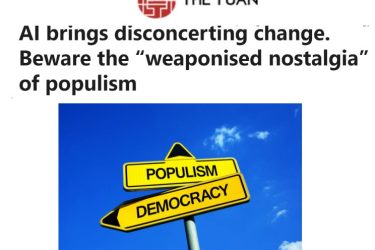The second in what looks like becoming a series of un-forecasts* – little glimpses of what may lie ahead in the century of two singularities.
The third one will be more optimistic. Honest.
In the five years of President Trump, corporate taxes were slashed and federal spending on infrastructure projects was boosted. Companies and individuals were exhorted (and sometimes extorted) to buy American, and imports were cut by tariff and non-tariff barriers. The impact was profound. Initially, US GDP rose sharply as its firms repatriated hundreds of $billions of profits from their foreign subsidiaries, and jobs were created to carry out the infrastructure projects.
But the government spending was inefficient, and there were persistent reports of large-scale corruption, some of it involving members of the Trump family. Cross-border trade and investment slumped as more and more countries retaliated against US protectionism.
More importantly, job growth was constrained and then outweighed by the beginnings of cognitive automation, and the unmistakeable signs of widespread and lasting technological unemployment.e beginnings of cognitive automation, and the unmistakeable signs of widespread and lasting technological unemployment.
By the end of Trump’s term, inflation was rising fast, along with the national debt. Unemployment was at 15%, and regional military conflicts were becoming both chronic and acute as America had withdrawn from its role as the global peace-keeper. Americans were increasingly scared, and they looked for a scapegoat. President Trump declined the Republican Party’s fretful offer to be its candidate again in 2020, and railed against (and frequently sued) anyone who criticised his track record, blaming Muslims, Mexicans, and the covert activities of “internal traitors”, who he declined to identify.
Polls showed the Republicans heading for electoral disaster, and a tight contest between a reluctant Michelle Obama and a rising new party which called for law and order, a clamp-down on dissent and protest, internment for certain racial minorities, and a major increase in military expenditure. Hundreds of thousands of newly unemployed people participated in mass rallies, wearing armbands and giving identical salutes to the party’s garish flag.
* This un-forecast is not a prediction. Predictions are almost always wrong, so we can be pretty confident that the future will not turn out exactly like this. It is intended to make the abstract notion of technological unemployment more real, and to contribute to scenario planning. Failing to plan is planning to fail: if you have a plan, you may not achieve it, but if you have no plan, you most certainly won’t. In a complex environment, scenario development is a valuable part of the planning process. Thinking through how we would respond to a sufficient number of carefully thought-out scenarios could well help us to react more quickly when we see the beginnings of what we believe to be a dangerous trend.


